-
Vanuatu: Teachers Union issues 30-day strike notice
Vanuatu Teachers Union (VTU) through its Secretary General (SG), Jonathan Yonah have issued a 30-day notice of industrial action commencing from January 3, 2024.
- windsornewstoday.ca Feds face massive class action filed by two Leamington migrant workers
Toronto lawyer Louis Century of the law firm Gold Blatt Partners filed a Statement of Claim on behalf of Kevin Palmer, a Jamaican who worked at Amco, and former Tilray worker Andrel Peters of Grenada last month.

-
Union accuses Postal Corporation management of violating workers’ rights
Brian Grimes, President of the Grenada Public Workers Union (GPWU), is accusing the management of the Grenada Postal Corporation (GPC) of engaging in tactics that can bust the union and, at the same time, violate Section 11 of the Grenada Constitution and Sections 40 and 41 of the Labour Relations Act.
- www.abc.net.au Seasonal workers and their Australian dollars are changing the Pacific. But at what cost?
With the nation's growing dependence on a Pacific Islander workforce, especially in regional areas, attention is shifting towards improving worker welfare and wellbeing.

- newnaratif.com Migrant Domestic Workers in Malaysia: Forced Labour and its Catalysts – New Naratif
According to a report by the International Labour Organization, one-third of migrant domestic workers in Malaysia are toiling as forced labourers. But what exactly is forced labour and what makes migrant domestic workers vulnerable to such modern-day slavery in Malaysia?

- www.bbc.com Oxfam shop and office workers strike for first time
The walkout is over pay with some staff at the anti-poverty charity reporting having to use foodbanks, a union says.

- cleanclothes.org Open letter to brands producing in Bangladesh
To H&M, Bestseller, Next, Primark, C&A, Uniqlo, M&S, Puma, VF Corp., PVH, Walmart and Zara, and all international brands producing clothes in Bangladesh:

To H&M, Bestseller, Next, Primark, C&A, Uniqlo, M&S, Puma, VF Corp., PVH, Walmart and Zara, and all international brands producing clothes in Bangladesh:
-
Burger King gave candy to a worker who never called in sick. The internet gave $400k [FULL TEXT]
Burger King cook and cashier Kevin Ford was happy to receive a small goody bag from management as a reward for never calling in sick. But people on the internet were less thrilled. They believed Ford deserved more — over $400,000 more.
Last May, Ford was given a coffee cup, a movie ticket, some candy and few other small items for working over 20 years at Burger King without ever using a sick day, meaning he never took time off unexpectedly.
"I was happy to get this because I know not everyone gets something," said Ford, who works at the Burger King in Harry Reid International Airport in Las Vegas.
Ford, a big believer in appreciating small gestures in life, showed off the goody bag on TikTok. The video went viral, partly because people were outraged on his behalf.
While many on social media said they respected Ford's work ethic and positive attitude, they also argued that he deserved more than a bag of treats for prioritizing his job over his health.
That led his daughter, Seryna, to start a GoFundMe campaign last June in hopes of raising some money for her father to visit his grandchildren in Texas.
She set the goal to $200. Over the next year, the campaigned amassed over $400,000 in donations, while people flooded Ford's inbox with messages of how he reminded them of their own father, brother or friend.
"I think they just wanted to show my employer and other CEOs that people deserve to be congratulated, rewarded, even just acknowledged for their hard work and dedication," he said. Like Ford, many restaurant workers don't get paid sick leave
As a single father with four daughters, Ford never took sick days because frankly, he couldn't afford to. Ford's job — like more than half of restaurant and accommodation jobs as of 2020 — does not offer paid sick leave, meaning workers typically do not get paid for missing work due to illness unless they dip into their paid vacation time.
Ford said he only ever missed work for medical reasons twice in his Burger King career — once for a surgery related to his sleep apnea, another for a spine procedure caused by working long hours on his feet. Even then, he used his vacation days to take that time off.
"I'd be laying down in front of the fryers because I was in so much pain and people would tell me to go home, but I was thinking about the power bill or the water bill," Ford added.
Ford is not alone. Across the country, many workers make the difficult choice between taking unpaid time off or muscling through their shift when they're sick. That issue magnified over the pandemic, as people quit their jobs in droves due to a lack of paid sick leave.
A Burger King spokesperson told NPR, "Decisions regarding employee benefits are made at the sole discretion of its individual franchisees including the franchise group that employs Kevin Ford." Ford had deep regrets about how often he worked
Despite the overwhelming support on social media, Ford has been using his new platform to warn people: "Don't be like me."
His job was not worth the heavy toll on his body and mental health, he said. It was also difficult for his four daughters, who often saw Ford come home from work after 10 p.m.
Ford said he learned that lesson the hard way.
Before he went viral on social media, Ford said he was at the lowest point of his life. He was dealing with a divorce, the deaths of his parents and the departure of his children, who had grown up and moved away. After work, Ford would drive for hours around his neighborhood reflecting on his life and what he would have done differently.
"There was nothing but work in my life," Ford said. "Looking back, what was it all for? Why I was not missing days that I could've spent with my kids and my wife?"
That's why Ford has described the fundraiser as a second chance. Not only does he have enough money for his retirement and to help pay for his grandchildren's college educations, but he can also afford to take days off work and make up for lost time with his children.
He plans to keep working at Burger King, largely because he likes his coworkers.
"That's also my family there. We're fun and funny," he said. "When it's not like that, then I guess I'll retire."
-
US Department of Labor finds 5 Florida skating rinks illegally employing minors later than allowed, assesses $26K in civil penalties [FULL TEXT]
Investigation findings: U.S. Department of Labor investigators found the employers allowed 33 employees – 14- and 15-year-olds – to work outside of legally allowed hours, a violation of the child labor provisions of the Fair Labor Standards Act. Specifically, the employer let the minors work past 7 p.m. while school was in session, past 9 p.m. between June 1 and Labor Day, more than three hours when school was in session, more than eight hours on non-school days and more than 18 hours during school weeks.
In addition, the employers failed to keep accurate records documenting the ages of the minor employees.
Civil money penalties assessed: $26,103 to address child labor violations.
Quote: “Federal law requires employers must balance their needs with their obligations to provide young workers with useful work experiences without jeopardizing their well-being or schooling opportunities,” said Wage and Hour Division District Director Nicolas Ratmiroff in Tampa, Florida. “We encourage, employers, parents, educators and young workers to use the variety of resources we provide to help understand their obligations and rights under the law.”
Background: From fiscal year 2020 through 2022, the division assessed employers more than $2.8 million in penalties and conducted more than 500 child labor investigations affecting nearly 2,900 minors in Alabama, Florida, Georgia, Kentucky, Mississippi, North Carolina, South Carolina and Tennessee.
Employers can also contact the Wage and Hour Division at its toll-free number, 1-866-4-US-WAGE. Learn more about the Wage and Hour Division, including information about protections for young workers on the department’s YouthRules! website. Workers can call the Wage and Hour Division confidentially with questions – regardless of where they are from – and the department can speak with callers in more than 200 languages.
-
Federal investigation into employee’s fatal fall finds San Antonio wire drawing company willfully exposed workers to unsafe forklift hazards [FULL TEXT]
A federal investigation has found that a San Antonio wire drawing company could have prevented an employee from suffering fatal injuries by following required workplace safety standards.
Investigators with the U.S. Department of Labor’s Occupational Safety and Health Administration opened an inspection in February 2023 at WMC San Antonio LLC and learned the company allowed employees to ride atop an unsecured, site-made forklift attachment to move wire mesh bundles at the plant. At the time of the incident, the deceased worker was transporting bundles to flat-bed trailers when the attachment slid off the forks, causing them to fall. The employer had tasked workers with moving material from the plant to another WMC location as the company prepared to close the San Antonio facility.
OSHA issued WMC a willful citation for failing to provide fall protection for employees working at heights up to 13 feet. The company also received a second willful citation for exposing workers to fall and struck-by hazards by allowing them to ride on improper and unsecured forklift attachments. The agency has proposed $299,339 in penalties for its violations.
“WMC San Antonio ignored the well-documented dangers of using unauthorized forklift attachments and an employee’s family, friends and co-workers are left to grieve their loss,” said OSHA Area Director Alex Porter in San Antonio, Texas. “This company publicly claims that employee safety and well-being is a priority but then unnecessarily exposed workers to serious dangers. In this case, actions would have meant much more than words.”
Founded in 2003 in Jacksonville, Florida, WMC San Antonio is now based in The Woodlands. The company also has mill facilities in Texas as well as California, Illinois, Pennsylvania and South Carolina.
OSHA’s stop falls website offers safety information and video presentations in English and Spanish to teach workers about fall hazards and proper safety procedures.
WMC San Antonio LLC has 15 business days from receipt of citation and penalties to comply, request an informal conference with OSHA's area director, or contest the findings before the independent Occupational Safety and Health Review Commission.
-
it feels awful to just keep working like it's "business as usual" while the planet crumbles around us.
this feels like the most clearly I've been able to put the sentiment into words. I'm not exactly a fan of the wage slavery system we live in in general, but when continuing operations in the face of, or directly contributing to the decline of the environment, more than ever I feel like i/we shouldn't just be carrying on as normal, contributing to businesses ordinary operations as though nothing is wrong.
I know that my labour alone can't make or break the status quo, but I'm finding it harder and harder to justify being part of the problem when no attempts at a solution really seem to exist.
-
Many people feel they work in pointless, meaningless jobs, research confirms (Credit to @[email protected])
yiffit.net Many people feel they work in pointless, meaningless jobs, research confirms - Yiffit.netThe theory that many people feel the work they do is pointless because their jobs are “bullshit” has been confirmed by a new study. The research found that people working in finance, sales and managerial roles are much more likely than others on average to think their jobs are useless or unhelpful t...
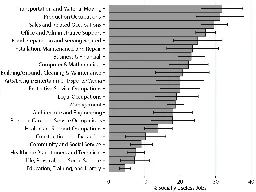
The theory that many people feel the work they do is pointless because their jobs are “bullshit” has been confirmed by a new study.
The research found that people working in finance, sales and managerial roles are much more likely than others on average to think their jobs are useless or unhelpful to others.
The study, by Simon Walo, of Zurich University, Switzerland, is the first to give quantitative support to a theory put forward by the American anthropologist David Graeber in 2018 that many jobs were “bullshit”—socially useless and meaningless.
Researchers had since suggested that the reason people felt their jobs were useless was solely because they were routine and lacked autonomy or good management rather than anything intrinsic to their work, but Mr. Walo found this was only part of the story.
He analyzed survey data on 1,811 respondents in the U.S. working in 21 types of jobs, who were asked if their work gave them “a feeling of making a positive impact on community and society” and “the feeling of doing useful work.”
The American Working Conditions Survey, carried out in 2015, found that 19% of respondents answered “never” or “rarely” to the questions whether they had “a feeling of making a positive impact on community and society” and “of doing useful work” spread across a range of occupations.
Mr. Walo adjusted the raw data to compare workers with the same degree of routine work, job autonomy and quality of management, and found that in the occupations Graeber thought were useless, the nature of the job still had a large effect beyond these factors.
Those working in business and finance and sales were more than twice as likely to say their jobs were socially useless than others. Managers were 1.9 more likely to say this and office assistants 1.6 times.
“David Graeber’s ‘bullshit jobs’ theory claims that some jobs are in fact objectively useless, and that these are found more often in certain occupations than in others,” says the study, published in the journal Work, Employment and Society.
"Graeber hit a nerve with his statement. His original article quickly became so popular that within weeks it was translated into more than a dozen languages and reprinted in different newspapers around the world.
"However, the original evidence presented by Graeber was mainly qualitative, which made it difficult to assess the magnitude of the problem.
"This study extends previous analyses by drawing on a rich, under-utilized dataset and provides new evidence.
“It finds that working in one of the occupations highlighted by Graeber significantly increases the probability that workers perceive their jobs as socially useless, compared to all others. This article is therefore the first to find quantitative evidence supporting Graeber’s argument.”
Law was the only occupation cited by Graeber as useless where Mr. Walo found no statistically significant evidence that staff found their jobs meaningless.
Mr. Walo also found that the share of workers who consider their jobs socially useless is higher in the private sector than in the non-profit or the public sector.
More information: Simon Walo, “Bullshit” After All? Why People Consider Their Jobs Socially Useless, Work, Employment and Society (2023). DOI: 10.1177/09500170231175771
-
How are people supposed to become experienced when no company will offer to train them? (Credit to u/DangerDan93 via Reddit)
> > > I'm so sick of this! Everyone keeps saying that the trades are desperate for workers, but no company wants to train them. They expect you to be in a good life situation to be able to go to school for the experience, but a lot of us have neither the money nor time to do so! School is expensive, you don't get paid for it, and most of us are one paycheck away from becoming homeless. How is this system sustainable? > >
-
Customers want instant gratification. Workers say it’s pushing them to the brink [FULL TEXT]
apnews.com Customers want instant gratification. Workers say it’s pushing them to the brinkDrastic changes in consumer demands are driving labor unrest in diverse industries upended by technology.

Six straight days of 12-hour driving. Single digit paychecks. The complaints come from workers in vastly different industries: UPS delivery drivers and Hollywood actors and writers.
But they point to an underlying factor driving a surge of labor unrest: The cost to workers whose jobs have changed drastically as companies scramble to meet customer expectations for speed and convenience in industries transformed by technology.
The COVID-19 pandemic accelerated those changes, pushing retailers to shift online and intensifying the streaming competition among entertainment companies. Now, from the picket lines, workers are trying to give consumers a behind-the-scenes look at what it takes to produce a show that can be binged any time or get dog food delivered to their doorstep with a phone swipe.
That workers are overworked and underpaid is an enduring complaint across industries — from delivery drivers to Starbucks baristas and airline pilots — where surges in consumer demand have collided with persistent labor shortages. Workers are pushing back against forced overtime, punishing schedules or company reliance on lower-paid, part-time or contract forces.
At issue for Hollywood screenwriters and actors staging their first simultaneous strikes in 40 years is the way streaming has upended the economics of entertainment, slashing pay and forcing showrunners to produce content faster with smaller teams.
“This seems to happen to many places when the tech companies come in. Who are we crushing? It doesn’t matter,” said Danielle Sanchez-Witzel, a screenwriter and showrunner on the negotiating team for the Writers Guild of America, whose members have been on strike since May. Earlier this month, the Screen Actors Guild–American Federation of Television and Radio Artists joined the writers’ union on the picket line.
Actors and writers have long relied on residuals, or long-term payments, for reruns and other airings of films and televisions shows. But reruns aren’t a thing on streaming services, where series and films simply land and stay with no easy way, such as box office returns or ratings, to determine their popularity.
Consequently, whatever residuals streaming companies do pay often amount to a pittance, and screenwriters have been sharing tales of receiving single digit checks.
Adam Shapiro, an actor known for the Netflix hit “Never Have I Ever,” said many actors were initially content to accept lower pay for the plethora of roles that streaming suddenly offered. But the need for a more sustainable compensation model gained urgency when it became clear streaming is not a sideshow, but rather the future of the business, he said.
“Over the past 10 years, we realized: ‘Oh, that’s now how Hollywood works. Everything is streaming,’” Shapiro said during a recent union event.
Shapiro, who has been acting for 25 years, said he agreed to a contract offering 20% of his normal rate for “Never Have I Ever” because it seemed like “a great opportunity, and it’s going to be all over the world. And it was. It really was. Unfortunately, we’re all starting to realize that if we keep doing this we’re not going to be able to pay our bills.”
Then there’s the rising use of “mini rooms,” in which a handful of writers are hired to work only during pre-production, sometimes for a series that may take a year to be greenlit, or never get picked up at all.
Sanchez-Witzel, co-creator of the recently released Netflix series “Survival of the Thickest,” said television shows traditionally hire robust writing teams for the duration of production. But Netflix refused to allow her to keep her team of five writers past pre-production, forcing round-the-clock rewrites with just one other writer.
“It’s not sustainable and I’ll never do that again,” she said.
Sanchez-Witzel said she was struck by the similarities between her experience and those of UPS drivers, some of whom joined the WGA for protests as they threatened their own potentially crippling strike. UPS and the Teamsters last week reached a tentative contract staving off the strike.
Jeffrey Palmerino, a full-time UPS driver near Albany, New York, said forced overtime emerged as a top issue during the pandemic as drivers coped with a crush of orders on par with the holiday season. Drivers never knew what time they would get home or if they could count on two days off each week, while 14-hour days in trucks without air conditioning became the norm.
“It was basically like Christmas on steroids for two straight years. A lot of us were forced to work six days a week, and that is not any way to live your life,” said Palmerino, a Teamsters shop steward.
Along with pay raises and air conditioning, the Teamsters won concessions that Palmerino hopes will ease overwork. UPS agreed to end forced overtime on days off and eliminate a lower-paid category of drivers who work shifts that include weekends, converting them to full-time drivers. Union members have yet to ratify the deal.
The Teamsters and labor activists hailed the tentative deal as a game-changer that would pressure other companies facing labor unrest to raise their standards. But similar outcomes are far from certain in industries lacking the sheer economic indispensability of UPS or the clout of its 340,000-member union.
Efforts to organize at Starbucks and Amazon stalled as both companies aggressively fought against unionization.
Still, labor protests will likely gain momentum following the UPS contract, said Patricia Campos-Medina, executive director of the Worker Institute at the School of Industrial and Labor Relations at Cornell University, which released a report this year that found the number of labor strikes rose 52% in 2022.
“The whole idea that consumer convenience is above everything broke down during the pandemic. We started to think, ‘I’m at home ordering, but there is actually a worker who has to go the grocery store, who has to cook this for me so that I can be comfortable,’” Campos-Medina said.
-
Labor unions across Nigeria protest against soaring cost of living under new president [FULL TEXT]
apnews.com Labor unions across Nigeria protest against soaring cost of living under new presidentLabor unions are marching across Nigeria to protest the soaring cost of living under the West African nation’s new president.

Labor unions marched across Nigeria on Wednesday to protest the soaring cost of living under the West African nation’s new president, with calls for the government to improve social welfare interventions to reduce hardship.
The unions, made up of government workers, said the economic incentives announced this week by Nigerian President Bola Tinubu to ease hardship were not enough. They also accused him of failing to act quickly to cushion the effect of some of his policies, including the suspension of decadeslong, costly subsidies that have more than doubled the price of gas, causing a spike in prices for food and most other commodities.
Tinubu on May 29 scrapped the subsidy that cost the government 4.39 trillion naira ($5.07 billion) while new leadership of the country’s central bank ended the yearslong policy of multiple exchange rates for the local naira currency, allowing the rate to be determined by market forces.
Both moves aimed to boost government finances and woo investors, authorities said. But they have had an immediate impact of further squeezing millions in Nigeria who were already battling surging inflation, which stood at 22.7% in June, and a 63% rate of multidimensional poverty.
“Since the subsidy removal, you can’t move from one place to another,” said Joe Ajaero, president of the Nigerian Labor Congress, the umbrella body of the unions. He was referring to the cost of transportation that has more than doubled in many cities, forcing a growing number of people to walk to work.
Ajaero said the labor unions have proposed an upward review of salaries but “the federal government has refused to inaugurate the committee on the proposal.”
“Mr. President can’t join the league of lamentations; he should come out openly and let us know those people who have cornered our commonwealth … and not to lament that some people have stolen our money,” said Ajaero, adding that the protest could continue for a long time.
One of the protesters, Usman Abdullahi Shagari, said he has been struggling to provide for his family, which includes five children, after the price of food items more than doubled.
“Feeding today is the most important thing,” said Shagari, 45. “Everything has increased, so that has affected the feeding of my family and my salary cannot withstand it.”
-
Unions work!


Original tweet:
Thousands of NYC public sector nurses are paid nearly $20,000 less than their counterparts in the private sector.
These 6,600 union nurses are refusing to settle for a contract that keeps them overworked and underpaid, and are escalating the struggle to get what they deserve.
New tweet:
UPDATE: NYC public hospital nurses just won a new union contract that includes improved staffing ratios and raises of 37 percent (or at least $32,000) over the next 5 years, their largest salary increase ever.
-
There are no solutions.


American: I have 2 jobs & still can't make rent--We need a living wage
GOP: Living wage? Go to college
American: I cant afford tuition
GOP: Ask your parents
American: They're still in college debt
GOP: Get a job
American: I just told you I have 2
GOP: Be born rich next time
-
Unions Build Wealth for the American Working Class [FULL TEXT]
Introduction and summary
Many Americans today struggle with low levels of savings, but unions offer working families a viable path to improving their financial well-being. Wealth is the difference between what people own and what they owe in debt, and building and maintaining wealth is crucial for families. Wealth allows workers to cover expenses during emergencies or periods of joblessness; put money toward purchasing a home or raising children; and fund a comfortable retirement. Unions may help families build wealth not only through increased income but also better job stability, benefits, and training.
A Center for American Progress analysis of the effects of union membership on wealth shows that being part of a union is associated with greater wealth for working-class families—defined as households without a four-year college degree—and especially working-class families of color. Because of this effect, unions are a crucial means for building wealth among the working class and reducing racial wealth gaps for workers without four-year college degrees. The key findings of this report include:
``` Working-class union households hold nearly four times as much median wealth ($201,240) as the typical working-class nonunion household ($52,221), suggesting that membership vastly increases wealth for working-class families. Union membership helps close the wealth gap between working class and college-educated households. While the median wealth of working-class nonunion households is just 17 percent that of college-educated nonunion households, the median wealth of working-class union households is 67 percent that of college-educated nonunion households. Union membership is tied to large dollar gains for all workers, but working families of color enjoy the largest percentage of gains. White working-class union families hold more than three times as much wealth as working-class nonunion households, while Black families hold more than four times as much wealth, nonwhite Hispanic families more than five times as much wealth, and families of other or multiple races or ethnicities have in excess of seven times as much wealth. Working-class families of all races and ethnicities are far more likely to own their own homes when part of a union.
```
Prior Center for American Progress Action Fund research has established that union membership significantly increases wealth for all households,1 and CAP research has shown that unions also narrow racial wealth gaps.2 This analysis builds on previous evidence to show that greater wealth for union households extends to the divide between working-class and college-educated Americans.
Background
Unions lead to higher wages, better benefits, and stronger on-the-job protections, all of which can contribute to increased wealth for union households.3 Unions directly increase wages for members of the working class4 as well as offer better benefits such as health insurance and retirement plans that further reduce individual expenses on health care and saving for retirement.5 Union workers also enjoy improved job stability, which prevents periods of unemployment; leads to fewer job changes, and thus lower costs; and results in wage growth on the job and a better chance of qualifying for retirement benefits at work.6 Job stability also creates peace of mind, which helps workers focus on the longer term and save more. These union benefits are particularly important for ensuring high job quality for workers without a college degree.
``` "The union wealth effect could increase wealth for millions of working-class Americans."
```
These factors enable workers to build wealth in multiple ways. Union membership is associated with significantly higher earnings over a worker’s entire lifetime, particularly for those without a college degree,7 directly raising total income. Improved benefits plans and increased job stability also alleviate the need for families to draw down their wealth to make up for lost income during spells of joblessness or to cover medical expenses that insurance does not cover.
Because the majority of workers in the United States do not have a college degree, the union wealth effect could increase wealth for millions of working-class Americans. Furthermore, because nearly half of the working class are workers of color—with Black, Hispanic, and other or multiple race or ethnicity workers making up 45 percent of the working class, and white workers comprising the remaining 55 percent—these findings cement the role of unions in advancing racial wealth equity.8
However, studies have shown that American households—especially members of the working class—struggle with low wealth. A 2022 survey found that nearly 1 in 3 American adults lacked the funds to cover an emergency expense of only $400,9 and the Federal Reserve’s 2010 through 2019 Survey of Consumer Finances (SCF) data used in this analysis showed that median working-class household wealth overall was $70,313 in that period, and 11.4 percent of working-class households had no wealth at all.
Workers across the country want to join unions. In fact, unions have reached their highest levels of support in more than half a century,10 and nearly half of U.S. workers stated that they would join a union if they could.11 However, forming a union in the United States is needlessly difficult, and weak federal labor laws fail to protect countless members of the working class who want to exercise their right to come together in collective bargaining. Policymakers who value the working class must advocate for stronger protections that enhance workers’ right to join unions. They can start by passing the Protecting the Right to Organize (PRO) Act,12 but there is much more that can be done, including preventing firms from deducting the costs of union busting13 and seizing the moment offered by the passage of President Joe Biden’s landmark industrial policy laws to ensure workers on jobs funded by federal spending have the chance to join a union.14 How do unions benefit working people?
Previous CAP research has shown that unions offer crucial economic gains for working families, such as:
``` Unions have long been a route to the middle class for workers without college degrees. The children of working-class parents in unions have higher earnings. Union membership can improve democratic participation, especially for workers with lower levels of education.
```
Findings
This report builds on previous CAP findings that union membership is associated with increased wealth for all workers and a narrower racial wealth gap. A 2021 CAP analysis of SCF data from 2010 through 2019 found that the median union household in the United States has more than twice the wealth of the median nonunion household. The 2021 analysis also found that Black households with a union member have median wealth that is more than three times that of Black nonunion households, and more than five times that of Hispanic households.
This report highlights how prior research about the role of unions in building wealth is especially important for the working class.15 Union membership is associated with increased wealth for working-class households
From 2010 to 2019, the median working-class union family had nearly four times as much wealth as working-class families not covered by a union contract. As shown in Figure 1, families without a four-year college degree that were covered by a union contract had a median wealth of $201,240, while working-class families without union contracts had a median wealth of only $52,221.
The analysis confirms that the increase in wealth associated with union membership in particular holds true for the working class. It also shows that the union wealth effect comes from more than just the higher incomes that union workers enjoy: Working-class families covered by a union contract enjoy a higher wealth-to-income ratio—2.6 compared with 0.96 for households not covered by a union contract. This suggests that, in addition to strengthening income, union membership allows working-class families to better sustain and grow their wealth over time. Union membership helps close the gap between working-class and college-educated households
Union members narrow the wealth divide between working class and college-educated households, offering working people an alternative to a college education for building wealth. The median wealth for working-class nonunion families is only 17 percent that of college-educated nonunion households, while the median wealth for working-class nonunion households is 67 percent that of college-educated nonunion households. As shown in Figure 2, the wealth gains help offer workers a route to the middle class outside of a four-year degree. (Unions also help boost wealth for college-educated workers: Union households with a college degree have a median wealth of $376,406—20 percent greater than college-educated nonunion households.)
The decline in union density across the United States has been shown to have exacerbated the earnings gap between college-educated and working-class Americans,16 and these findings further cement unions’ role in reducing inequality across the economy by extending the union effect on inequality to wealth.17 Unions offer households nearly as large a wealth increase as a college education 17.4%
Wealth held by the median nonunion household as a percentage of the median college-educated nonunion household 66.9%
Wealth held by the median union household as a percentage of the median college-educated nonunion household Union membership offers dollar benefits for all workers, but working families of color enjoy the greatest percentage gains
Unions help reduce the racial wealth gap in the working class, as families of color enjoy the greatest percentage gains in wealth associated with union membership. As shown in Figure 3, the dollar gains for white working-class families remain significant: White families covered by a union contract have a median wealth $210,475 higher than those who are not—a median wealth more than three times that of nonunion white families. For Black, Hispanic, and other or multiple race or ethnicity families, the ratio between union and nonunion median household wealth is far greater, although total wealth remains lower than that of white workers. Black working-class households covered by a union contract have more than four times the median wealth of Black working-class nonunion households; nonwhite Hispanic working-class households have more than five times the median wealth; and households of other or multiple nonwhite races and ethnicities have more than seven times the median wealth when covered by a union contract. Unions increase wealth and narrow racial wealth gaps for the working class 3.3x
as much median wealth for white union households 4.3x
as much median wealth for Black union households 5.4x
as much median wealth for nonwhite union Hispanic households 7.2x
as much median wealth for nonwhite other or multiple race union households Union membership helps working-class families afford their own homes
Working-class families covered by a union contract are far more likely to own their homes than those without a union contract. Figure 3 shows that this effect persists across racial categories, with a 13 percentage point higher rate of homeownership among working-class union households of all races and ethnicities. This increase is even higher for nonwhite Hispanic working-class households at 17 percentage points higher.
Homeownership has long been a key store of wealth in the United States, and higher wages and better benefits through union membership allow workers to make these crucial investments in themselves and their families by putting their savings toward purchasing a home. Improved job stability through union membership likely plays a role as well by simplifying the homebuying process and making it easier for families to afford consistent mortgage payments. No matter the measure, union membership offers substantially more wealth for working-class families
``` "Working-class union families have increased savings, a more comfortable retirement, and a lower likelihood of having no wealth at all."
```
Families build and store wealth in a variety of different ways, including saving wage income, putting money toward retirement plans, and homeownership, among other things. Union membership offers working-class families the ability to build wealth in all of these ways. The table below details common measures of household wealth, including median wealth; wealth-to-income ratio; rates of homeownership, having no net wealth, and holding pension plans; and value of pensions. This diverse array of measures shows that working-class union families have increased savings, a more comfortable retirement, and a lower likelihood of having no wealth at all , and often most prominently for working-class families of color.
Conclusion
Unions offer a crucial means for strengthening the wealth of working-class families and narrowing racial wealth gaps among the working class. Policymakers have made strides in starting to craft policies to create quality jobs for the working class, most notably through the economic legislation passed by the Biden administration as the Infrastructure Investment and Jobs Act, the CHIPS and Science Act, and the Inflation Reduction Act.
Still, there is a long way to go to ensure that workers are able to join unions and have access to the many ways by which union members can boost their wealth. Policymakers at the federal and state levels must properly implement these laws to encourage joint labor-management partnerships for training and safety, for example. Policymakers should also design industrial policies that benefit all of the working class, particularly those who are employed in services.18 Finally—and most directly—policymakers need to reform labor law to make it fairer and easier for workers to form a union and bargain collectively, and they can start by passing the PRO Act.
Methodology
This analysis builds on previous CAP work that demonstrated the existence of a union wealth premium, which in turn reduces racial wealth gaps. The authors used surveys from nearly a decade of SCF data that include demographic and wealth data for households across the United States, spanning from 2010 through 2019 and collected every three years.19 In total, four waves of SCF data were pooled together to produce sample sizes large enough for robust results and to cover the span of the single business cycle that followed the 2008 financial crisis and ended just prior to the onset of the COVID-19 pandemic.
The basic results presented in this paper persist even after accounting for other factors such as age, education, income, job stability, industry, and occupation, to name some of the most relevant ones. In addition, previous peer-reviewed analysis from two of the authors has demonstrated that the union wealth premium remains significant even when additional controls are taken into account.20 While it is possible that union members are simply more likely to work in higher-paying jobs or industries, as union density can vary considerably across sectors, a large body of research has shown that unions increase wages and other factors that allow households to build and maintain wealth. Definitions
The authors restricted the sample to only include households—used interchangeably with “families”—whose head of household or spouse is age 25 or older, not retired, and earning a wage or salary. This ensures that the nonunion families included are representative of workers who could enjoy wealth premiums if they joined unions; retired or self-employed respondents, for instance, could not join.
This analysis counted families as union households if their respondents or respondents’ spouses were covered by a union contract, regardless of whether those workers were union members. Therefore, the analysis may understate the role of unions because only one member of a household needed to be covered by a union contract in order for the entire household to be considered covered. For ease of language, the authors referred to the households included in the analysis as both “union households” and “union members.”
Households were considered working class if the respondent did not have a four-year college degree; households with a respondent with a four-year college degree or higher credential were considered college educated. Defining economic class by education, rather than income, allowed for more direct comparisons within and across class, as level of education remains relatively consistent for members of the labor force and does not vary as considerably with age or experience.
The analysis measured wealth as the sum of all marketable assets—such as checking accounts, real estate, stakes in firms, and vehicles—less all debt, including mortgages, credit card debt, and student loans. The wealth figure also includes the net present value of the income stream that workers expect to receive from a defined-benefit pension, if they have one. These values were adjusted for inflation—as were all dollar amounts in this analysis—and reported in 2019 U.S. dollars. The analysis focused on median wealth to convey outcomes of the typical household. Averages are often not as representative, as they were skewed by the top few percentages of households holding much more wealth than other households.
The “other or multiple race” category reported in this analysis includes all SCF respondents who do not solely identify as white, Black or African American, or nonwhite Latino or Hispanic, resulting in a diverse group that also includes Asian, American Indian, Alaska Native, Native Hawaiian, Pacific Islander, and other race or ethnicity, as well as multiple race or ethnicity families. Despite the diverse universe of experiences in this category, the Federal Reserve combines these households into one group due to sample size limitations before releasing their datasets to the public.
Furthermore, while the Federal Reserve reports Black or African American as the same category, for simplicity, the authors reported it as Black; similarly, the authors used Hispanic to report survey data that combine nonwhite Hispanic and Latino into the same response.
The positions of American Progress, and our policy experts, are independent, and the findings and conclusions presented are those of American Progress alone. A full list of supporters is available here. American Progress would like to acknowledge the many generous supporters who make our work possible.
-
Hotel Workers Strike against Scab Staffing App and Anti-Black Racism [FULL TEXT]
When Thomas Bradley showed up for his third shift at Laguna Cliffs Marriott Resort and Spa in Dana Point, California, on July 2 he encountered something new: a picket line.
The picket was part of a wave of strikes at Los Angeles-area hotels by members of UNITE HERE Local 11. Their contracts at 62 hotels expired June 30. The hotel workers’ top demand is for pay that will allow them to secure housing in a market that is pricing them out.
Bradley, who had been a hotel union member years before, stopped to talk to the picketing workers and then joined them, exercising his right to strike under labor law.
But there was a problem. Bradley had been hired by the hotel through a temporary staffing app called Instawork. The app didn’t have any mechanism to recognize that he was on strike, so it canceled his shifts not only at Laguna Cliffs, but also at other venues that were not on strike. He appealed, but the app mechanically rejected his appeal.
The union has identified at least six hotels using Instawork to hire scabs. BLACK WORKERS NOT HIRED
Bradley is Black, as are several other workers the hotel hired during the strike using Instawork. “To use a platform like Instawork to use us as pawns, I think that was kind of messed up,” Bradley said.
The striking workers, who are largely Latino, were also appalled once they learned about the app from Bradley. Their union has spent decades trying to get hotels to hire more Black workers, even putting into their contracts requirements that hotels recruit more Black workers.
Striking housekeeper Andrea Rodriguez summed up the situation: “This company brought in African American workers to break our strike, but once we came back in [3 days later] they let them go.
“We have open positions in housekeeping and they could have hired them permanently but they didn’t,” she said. “We didn’t think it was fair.” STRIKE THE APP
To defend Bradley, who lost all his shifts, and to call out the discrimination against the other Black Instawork workers, Rodriguez and her co-workers decided to walk out again July 24.
The union filed unfair labor practice charges against the hotel’s management company, Aimbridge. The union argues that because the app doesn’t recognize Instawork workers’ right to strike, the hotel is using an illegal management system.
The ULP also names Instawork and the Regents of the University of California, which owns Laguna Cliffs through a pension fund. Rooms there run from $800 to $2,000 a night.
Among other demands, the striking workers want the hotel to offer union jobs to the Instawork workers it dismissed—even though they crossed the picket line—and pay Bradley for the shifts the app cancelled because he went on strike. This time they stayed out for a week. UNQUALIFIED?
Hotel managers have for decades claimed to the union that they can’t find qualified Black workers. Local 11 Co-President Ada Briceño noted that although there were almost no Black workers employed at Laguna Cliffs, “all of a sudden they found seven Black workers for the strike.
“So [Bradley] is good enough to break the strike, but not good enough for them for health care, pension, for a sustainable job for himself and his loved ones,” Briceño said.
Black workers were traditionally a large part of the Los Angeles hotel industry, but Local 11 reports that most of its Black membership now works in industrial food production and stadium jobs.
Instawork Got Instaworse
Los Angeles hotel worker Thomas Bradley has been using the temporary staffing app Instawork as his primary source of jobs. “It’s attractive because of high base pay,” he said, “and they also give you a chance to get a foot in the door, like most of these agencies.”
But now, he said, “it’s had so many updates that it’s turned into a traditional job.” The app now gives businesses more of an upper hand: “They can get rid of us anytime, no questions asked.”
The app uses a rating system, but unlike Uber, where riders are doing the rating, in the case of Instawork, it’s bosses rating you. Higher ratings give you access to more shifts and even pay premiums if you reach the highest level, the app claims.
Instawork workers trade stories and shifts in group chats using WhatsApp. According to the union’s complaint, workers in one large chat discussed the hotel strikes and whether they had the right to refuse to work. Bradley’s experience indicated to them that the app would illegally retaliate, deterring them from striking when other workers at a hotel walked out.
This violation of labor rights by automated management systems is the sort of situation NLRB General Counsel Jennifer Abruzzo addressed in a memo last year. She said that automated systems and surveillance can deter workers from exercising their rights—and if they do, the Board should presume that employers are in violation of the law.
In the U.S. Senate, Bernie Sanders, Bob Fetterman and others have signed onto the “No Robot Bosses Act,” introduced by Bob Casey of Pennsylvania. The bill would require a human to be involved in discipline and firing decisions.
At the very least, Instawork could inform workers of their right to strike and provide a way for them to indicate that they are exercising their rights (perhaps a big red “I’m on Strike!” button?) without penalizing them.
Instawork claims it has 277,000 workers in the Los Angeles area. This may be due to parasitical data practices. Local 11 Co-President Ada Briceño said that after she entered Bradley’s phone number into her phone, she received a text, supposedly from him, suggesting she pick up shifts through Instawork. She knew it wasn’t really from Bradley because they were together at the time, attending a California Board of Regents meeting about the Laguna Cliffs situation. “I just had to laugh,” she said.
Bradley said he’s been trying to get a permanent hotel job for more than a decade, and suggested that discrimination was the reason he was passed over. “I think I’ve proven myself, and it’s still not enough,” he said.
UNITE HERE has negotiated contract language to push hotels to hire Black workers, starting in Local 1 in Chicago in 2006, with similar language in contracts in Boston and Los Angeles.
“Often we’re put against each other, right?” said Briceño. “So through all these years that we’ve been bargaining, we take the opportunity to educate our top leaders, folks that come to the negotiation, to understand the need to speak with one voice for the workers and the inclusion of Black workers.”
The contracts say that the hotels and the union are required to work together to recruit Black workers; Local 11 also has a training fund with a priority on Black workers. The union trained over 600 Black workers for hotel work in the last year, Briceño said. The fund places workers in hotels where the union has affirmative action language committing hotels to hire them.
In the current negotiations, Briceño said, the union is proposing to standardize the best language about hiring Black workers to cover all 62 of the region’s union hotel properties, with 15,000 members. HOUSING CATASTROPHE
For Bradley, though, the worst was yet to come. He continued picking up hotel shifts until the strike wave hit the Anaheim Hilton, where he was scheduled to work. Again he joined the picket line.
This time, he tried writing to Instawork’s help desk explaining why he wasn’t coming in. He also informed hotel management. Despite these efforts, the app canceled all his upcoming shifts and suspended him, so he couldn’t get any more work.
“I was looking forward to working those shifts, because I needed the money,” he said. “My month was planned.” But after the suspension his plans were “completely destroyed.” He had been living in his car, but it was repossessed.
Bradley said living in his car made economic sense. The jobs he was getting from Instawork were so far away from where he lived that he was never at his apartment. He was traveling as far away as San Diego.
As housing costs have risen in Los Angeles, Bradley’s housing situation is becoming more common, even for union hotel workers. In 2018, the union’s bargaining surveys started to reflect that the housing crisis was hitting their members hard, making it their top concern.
The union surveyed members at one large hospitality employer and found that 1 in 10 had experienced homelessness in the last two years.
Rodriguez said her family of five lives in a small two-bedroom apartment that costs $2,300 a month for rent alone. “It’s too expensive,” she said in Spanish. “We can’t make ends meet. My husband’s a gardener, and it’s not enough.” She mentioned that they were in debt.
Housing prices are forcing workers to use apartments in shifts, or cram into the garages of family or friends, or move far inland to more affordable desert towns like Lancaster or Victorville, a two-hour drive. The commute is so long and expensive that some end up sleeping in their cars during the week, only seeing their families and homes on days off.
To deal with the rising costs, the union wants an immediate $5-an-hour wage hike and an additional $3 in each subsequent year of the contract. The hotel group’s counteroffer is less than half that. Meanwhile the giant Westin Bonaventure in Los Angeles, with 600 union hotel workers, settled before the contract expired.
The union is also pushing the hotels to support a ballot measure to stop hotel construction from displacing workers, and to use public funds to house homeless people in vacant hotel rooms. Last year voters in the city of Los Angeles approved a 4 percent tax on properties that sell for over $5 million. The money, around $900 million annually, will go to affordable housing.
Bradley’s suspension from Instawork mysteriously ended after reporters called the company. In late July, he was able to find a regular job at a union hotel. He has gone through orientation there, and is currently a probationary employee. But he cautioned that this doesn’t mean discrimination isn’t real. “It still exists,” he said.
“I’m pointing fingers at the gig economy, I’m pointing fingers at their hiring practices, and I’m also pointing fingers at their policies—their policies need to change.”
-
Labor battle brews as Trump rallies in Biden's backyard [FULL TEXT]
www.politico.com Labor battle brews as Trump rallies in Biden's backyardTrump’s Pennsylvania return foreshadows a ‘24 Keystone State showdown.

Donald Trump talked up his appeal to labor groups in hotly contested Erie County Saturday evening, a western Pennsylvania bellwether Joe Biden won by a razor-thin margin almost three years ago.
Known for its labor union roots, Erie County is emblematic of the ongoing battle for organized labor ahead of next year’s election, particularly if the country sees another Biden-Trump rematch. Trump, who won the support of many rank-and-file union members seven years ago, is currently vying for an endorsement from the United Auto Workers union.
UAW’s president Shawn Fain has criticized the Biden administration for pumping out billions in subsidies for electric vehicles without requiring higher wages and other protections. The union has so far withheld its support from Biden, frustrating current and former Biden aides.
Alongside slamming the Biden administration’s green energy policies, Trump on Saturday spoke about his attempt to win over workers to his — and the GOP’s — cause.
“Don’t forget the Democrats start off with a big advantage, they think they have the unions,” he said. “I happen to think the unions, the workers … we have a lot of the people in the unions with us. I think we have largely a majority. You’ve got to win that whole East Coast.”
Trump’s campaign stop marked his second trip to the state in a month, after Biden held his first political event of his reelection bid in June with a union rally in his regular haunt of Philadelphia. Labor groups, including the AFL-CIO, threw their support behind the president last month, with the AFL-CIO noting that it was the earliest in a presidential cycle that the group had endorsed a presidential candidate. Biden often calls himself the most “pro-union” president and a son of Scranton, Pa.
In 2020, Erie was one of two of Pennsylvania’s 67 counties that flipped from Trump to Biden. The city of Erie, its suburbs and rural pockets have played a pivotal role in determining which direction the state goes. Erie’s surrounding county voted for President Barack Obama twice before Hillary Clinton lost the county by fewer than 2,000 votes.
On Saturday, Trump slammed Washington’s “betrayal of workers … particularly in Pennsylvania.” He talked up his administration’s enactment of the USMCA trade deal to replace NAFTA.
He further touted his administration’s economic policies including tariffs on steel. “It’s the economy, stupid,” he said, echoing Bill Clinton’s famous election mantra in what he said could be the defining issue of the 2024 election.
“Since Joe Biden took over, he has wrecked our economy,” he added, before citing a litany of economic factors he claimed were in his previous administration’s favor, including worker productivity.
“I will defend Pennsylvania energy jobs including fracking,” he added to cheers. “We want American workers working.”
But Trump’s focus was fleeting. His speech was combative, largely focused on his own legal troubles, attacking his rivals for the GOP presidential nomination and relitigating his 2020 election loss.
In perhaps the most notable moment, Trump called on congressional Republicans to withhold military support to Ukraine “until the FBI, DOJ and IRS hand over every scrap of evidence they have on the Biden Crime Family’s corrupt business dealings.”
The language echoed his demands as president that Ukraine announce an investigation into the Bidens, which spurred his first impeachment.
Democrats on Saturday were out in full force ahead of Trump’s rally, a preview of the contentious 2024 battle set to play out in the key swing state. In 2020, Biden won Pennsylvania by just 1.2 percentage points, and Erie County by 1,400 votes, a small margin that Trump — if he manages to secure the GOP nomination — is working to turn back in his favor.
The DNC announced a new five-figure digital ad buy in the battleground state on Saturday, contrasting “Trump’s countless unfulfilled promises” with Biden’s record on job creation, infrastructure and health care. The ad, titled “Trump talks. Biden delivers,” shows a split-screen of the former and current presidents.
“As Trump takes his lies to Pennsylvania and across the country, the DNC will constantly remind voters of the stark differences between Trump’s abysmal economic agenda and the numerous accomplishments President Biden has delivered for working families,” DNC chair Jaime Harrison said in a statement.
The AFL-CIO’s secretary-treasurer, Fred Redmond, and T.J. Sandell, of Erie, a union plumber with Plumbers Local 27 and president of the Great Lakes Building and Construction Trades Council, accused the former president of having an “anti-worker record,” on a Saturday morning press call as Trump continues to make a play for organized labor, most recently vying for an endorsement from the United Auto Workers.
“Donald Trump doesn’t care about workers. Trump undermined workers’ rights. Trump rolled back workplace safety rules. He delivered massive tax giveaways to the extremely rich and big corporations while not lifting a finger to help struggling working people in Erie and so many other communities around the country,” Redmond said.
Trump’s event at Erie Insurance Arena comes just days after federal prosecutors rolled out additional charges against the former president in the classified documents case. In a separate investigation, special counsel Jack Smith’s team also appears to be on the verge of indicting him for efforts to subvert the results of the 2020 election in several states, including in Pennsylvania.
-
Department of Labor finds Louisiana, Texas McDonald’s franchisees allowed minors to work longer, later than law permits, operate dangerous equipment [FULL TEXT]
Federal investigations at 16 McDonald’s franchise locations in Louisiana and Texas have found child labor violations affecting 83 minors, the Department of Labor announced today.
In Louisiana, investigators with the department’s Wage and Hour Division discovered CLB Investments LLC in Metairie employed 72 workers, 14- and 15-years-old, to work longer and later than the law permits at 12 restaurants in Kenner, Jefferson, Metairie and New Orleans. The division determined the employer allowed three children to operate manual deep fryers, a task prohibited for employees under age 16. The department assessed CLB Investments with $56,106 in civil money penalties for violations found at 12 locations, one of which is now closed.
The division also found similar violations at four McDonald’s locations operated in Texas by Marwen & Son LLC in Cedar Park, Georgetown and Leander. Investigators found the company employed 10 minors, 14- to 15-years-old, to work hours longer and later than permitted. They also learned the employer allowed seven children to perform jobs prohibited or considered hazardous for young workers. Specifically, the employer allowed all seven to operate a manual deep fryer and oven, and two of the seven to also use a trash compactor. The department assessed Marwen & Son with $21,466 in civil money penalties for its violations.
“Employers must never jeopardize the safety and well-being of young workers or interfere with their education,” explained Wage and Hour Division Regional Administrator Betty Campbell in Dallas. “While learning new skills in the workforce is an important part of growing up, an employer’s first obligation is to make sure minor-aged children are protected from potential workplace hazards.”
These findings follow a May 2023 announcement of federal investigations that found child labor violations by three McDonald’s franchise operators in Kentucky involving more than 300 children at 62 locations in four states.
“The Fair Labor Standards Act allows for appropriate work opportunities for young people but includes important restrictions on their work hours and job duties to keep kids safe,” Campbell added. “Employers are strongly encouraged to avoid violations and their potentially costly consequences by using the many child labor compliance resources we offer or by contacting their local Wage and Hour Division office for guidance.”
The YouthRules! initiative promotes positive and safe work experiences for teens by providing information about protections for young workers to youth, parents, employers, and educators. Through this initiative, the U.S. Department of Labor and its partners promote developmental work experiences that help prepare young workers to enter the workforce. The Wage and Hour Division has also published Seven Child Labor Best Practices for Employers to help employers comply with the law.
In fiscal year 2022, the division found child labor violations involving 3,876 children nationwide, an increase of more than 60 percent since 2018.
Learn more about the Wage and Hour Division, including a search tool to use if you think you may be owed back wages collected by the division. Employers and workers can call the division confidentially with questions, regardless of where they are from. The department can speak with callers in more than 200 languages through the agency’s toll-free helpline at 866-4US-WAGE (487-9243).
Download the agency’s new Timesheet App, which is available in English and Spanish for Android and Apple devices, to ensure hours and pay are accurate.
-
Trimmed trees outside LA studio become flashpoint for striking Hollywood writers and actors [FULL TEXT]
apnews.com Trimmed trees outside LA studio become flashpoint for striking Hollywood writers and actorsA row of tightly trimmed ficus trees along a stretch of sidewalk outside Universal Studios has become a hot spot in the face-off between Hollywood studios and striking screenwriters and actors.
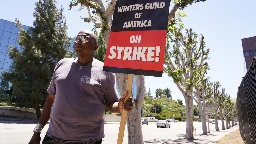
A row of tightly trimmed ficus trees along a stretch of sidewalk outside Universal Studios has become a hot spot in the face-off between Hollywood studios and striking screenwriters and actors.
Some members of the Screen Actors Guild-American Federation of Television and Radio Artists and Writers Guild of America unions — along with sympathetic local politicians — think the studio purposely pruned the trees in an effort to remove a source of shade for workers picketing under the hot Southern California sun. They gathered regardless on Wednesday, with one woman wearing a green wreath on her head and holding a sign depicting a full, untrimmed tree under the words “Never Forget.”
“Universal, get your ducks in order. We don’t want to see any more shady nonsense because the people are watching,” said Konstantine Anthony, a SAG-AFTRA member and the Democratic mayor of nearby Burbank.
Burbank’s city limits don’t include the stretch of Barham Boulevard where the trees were trimmed, which is part of Los Angeles. Anthony said he had consulted with Los Angeles political leaders about the trimming.
“We can’t find any work orders done for this particular tree trimming, which is problematic because in Southern California we have a lot of laws governing trees,” he said. “Normally, you don’t trim until October, and in fact, the exact same style and type of tree about 200 feet this way are not trimmed. But those aren’t providing shade to the picketers, are they?”
Los Angeles City Council member Nithya Raman, whose district includes Universal City, said in a statement that no permits had been issued for tree trimming at the site. City Controller Kenneth Mejia said his office was investigating the issue.
An NBCUniversal spokesperson said in a statement that it knew the trimming had “created unintended challenges for demonstrators, that was not our intention.” The studio said it was working to provide some shade coverage for picketers.
-
"We've Changed the Game": Teamsters Win Historic UPS Contract - International Brotherhood of Teamsters [FULL TEXT]
teamster.org “We’ve Changed the Game”: Teamsters Win Historic UPS Contract(WASHINGTON) – Today, the Teamsters reached the most historic tentative agreement for workers in the history of UPS, protecting and rewarding more than 340,00

Today, the Teamsters reached the most historic tentative agreement for workers in the history of UPS, protecting and rewarding more than 340,000 UPS Teamsters nationwide. The overwhelmingly lucrative contract raises wages for all workers, creates more full-time jobs, and includes dozens of workplace protections and improvements. The UPS Teamsters National Negotiating Committee unanimously endorsed the five-year tentative agreement.
“Rank-and-file UPS Teamsters sacrificed everything to get this country through a pandemic and enabled UPS to reap record-setting profits. Teamster labor moves America. The union went into this fight committed to winning for our members. We demanded the best contract in the history of UPS, and we got it,” said Teamsters General President Sean M. O’Brien. “UPS has put $30 billion in new money on the table as a direct result of these negotiations. We’ve changed the game, battling it out day and night to make sure our members won an agreement that pays strong wages, rewards their labor, and doesn’t require a single concession. This contract sets a new standard in the labor movement and raises the bar for all workers.”
“UPS came dangerously close to putting itself on strike, but we kept firm on our demands. In my more than 40 years in Louisville representing members at Worldport — the largest UPS hub in the country — I have never seen a national contract that levels the playing field for workers so dramatically as this one. The agreement puts more money in our members’ pockets and establishes a full range of new protections for them on the job,” said Teamsters General Secretary-Treasurer Fred Zuckerman. “We stayed focused on our members and fought like hell to get everything that full-time and part-time UPS Teamsters deserve.”
“Rank-and-file members served on the committee for the first time, so we got to show up every day to support our fellow Teamsters and share their stories,” said Brandy Harris, a part-time UPS Teamster with Local 174 in Seattle and a member of the Teamsters National Negotiating Committee. “Our hard work has paid off — from those members and leaders negotiating for more at the table to my sisters and brothers building a credible strike threat around the country. Our union was organized and we were relentless. We’ve hit every goal that UPS Teamster members wanted and asked for with this agreement. It’s a ‘yes’ vote for the most historic contract we’ve ever had.”
Highlights of the tentative 2023-2028 UPS Teamsters National Master Agreement include:
``` Historic wage increases. Existing full- and part-time UPS Teamsters will get $2.75 more per hour in 2023. Over the length of the contract, wage increases will total $7.50 per hour.
Existing part-timers will be raised up to no less than $21 per hour immediately, and part-time seniority workers earning more under a market rate adjustment would still receive all new general wage increases.
General wage increases for part-time workers will be double the amount obtained in the previous UPS Teamsters contract — and existing part-time workers will receive a 48 percent average total wage increase over the next five years.
Wage increases for full-timers will keep UPS Teamsters the highest paid delivery drivers in the nation, improving their average top rate to $49 per hour.
Current UPS Teamsters working part-time would receive longevity wage increases of up to $1.50 per hour on top of new hourly raises, compounding their earnings.
New part-time hires at UPS would start at $21 per hour and advance to $23 per hour.
All UPS Teamster drivers classified as 22.4s would be reclassified immediately to Regular Package Car Drivers and placed into seniority, ending the unfair two-tier wage system at UPS.
Safety and health protections, including vehicle air conditioning and cargo ventilation. UPS will equip in-cab A/C in all larger delivery vehicles, sprinter vans, and package cars purchased after Jan. 1, 2024. All cars get two fans and air induction vents in the cargo compartments.
All UPS Teamsters would receive Martin Luther King Day as a full holiday for the first time.
No more forced overtime on Teamster drivers’ days off. Drivers would keep one of two workweek schedules and could not be forced into overtime on scheduled off-days.
UPS Teamster part-timers will have priority to perform all seasonal support work using their own vehicles with a locked-in eight-hour guarantee. For the first time, seasonal work will be contained to five weeks only from November-December.
The creation of 7,500 new full-time Teamster jobs at UPS and the fulfillment of 22,500 open positions, establishing more opportunities through the life of the agreement for part-timers to transition to full-time work.
More than 60 total changes and improvements to the National Master Agreement — more than any other time in Teamsters history — and zero concessions from the rank-and-file.
```
On July 31, representatives of the 176 UPS Teamster locals in the U.S. and Puerto Rico will meet to review and recommend the tentative agreement. All UPS rank-and-file members will receive a list of improvements in the contract. Locals will conduct member meetings and Teamsters will have several weeks to vote on the offer electronically. Member voting begins August 3 and concludes August 22.
The UPS Teamsters National Master Agreement is the single largest private-sector collective bargaining agreement in North America.
Founded in 1903, the Teamsters Union represents 1.2 million hardworking people in the U.S., Canada, and Puerto Rico. Visit Teamster.org to learn more and follow us on Twitter @Teamsters and on Facebook at Facebook.com/teamsters.
-
Bloody Friday (Minneapolis, 1934) On this day in 1934, police shot into a crowd of workers participating in the Minneapolis General Strike, killing two and wounding sixty-seven in an event known... -
lemmy.world Bloody Friday (Minneapolis, 1934) On this day in 1934, police shot into a crowd of workers participating in the Minneapolis General Strike, killing two and wounding sixty-seven in an event known... - Lemmy.world## Bloody Friday (Minneapolis, 1934) ### Fri Jul 20, 1934 Image [https://stahmaxffcqankienulh.supabase.co/storage/v1/object/public/event-photos/Events/minneapolisGeneralStrike.jpg] Image: Striking truck drivers battle police in Minneapolis, 1934 [libcom.org [http://libcom.org]] — On this day in 1934...
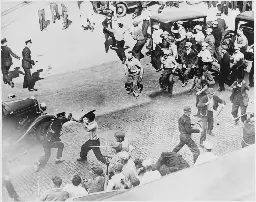
- lemmy.studio Wife's boss is on a power trip. Is this legal? - lemmy.studio
My wife works in a restaurant, and the power-tripping manager has instituted a new policy where all shift changes must be approved by management. I think that is reasonable enough, but they’re also asking the originally-scheduled employee why they are switching shifts, then approving or denying base...
-
Pay to Rise as Much as 40% in Deal Reached by United and Pilots [Full text]
web.archive.org Pay to Rise as Much as 40% in Deal Reached by United and PilotsThe proposed four-year agreement would be worth $10 billion over the life of the contract.
United Airlines pilots reached agreement with the company on Saturday on a contract valued at $10 billion that would increase pay up to 40 percent over four years.
The proposed contract offers another big wage victory for pilots in the United States after a deal with Delta Air Lines was approved in March. The substantial raises are a reflection of a shortage of pilots in the United States and the strong recovery in demand for air travel.
In addition to the higher compensation, the agreement provides better job security, work rules, vacation, retirement and other benefits.
At a major airline like United, pilots easily earn six-figure salaries. The most senior pilots, who typically fly larger planes on international routes, can earn several hundred thousand dollars a year.
In a statement, United, which is based in Chicago, said the deal would help its “United Next” strategy, an expansion plan that includes the purchase of larger planes to increase in the number of seats per flight in North America by almost 30 percent and the number of premium seats per flight by 75 percent by 2026.
“We promised our world-class pilots the industry-leading contract they deserve, and we’re pleased to have reached an agreement,” Scott Kirby, chief executive at United Airlines, wrote on the social media network LinkedIn.
Union officials said the agreement was the result of four years of negotiations and represented a “landmark” deal in the airline industry as travel demand rises after the steep drop during the height of the pandemic.
“The tireless dedication demonstrated by United pilots over the past several years ensured our solidarity, which was instrumental in achieving this historic agreement,” Capt. Garth Thompson, chairman of the Master Executive Council of the United Air Line Pilots Association International, said in a statement.
The Air Line Pilots Association, the largest airline pilot union in the world, represents 74,000 pilots at 42 airlines in the United States and Canada, including 16,000 pilots at United Airlines.
The union and management will now complete the final language of the deal. The agreement must then be approved by a vote of the members of the pilots association, which is expected in the next several weeks.
In March, Delta approved a contract that increases wages 34 percent by 2026 and includes improvements to scheduling, retirement and other benefits. Delta’s deal raised the standard for pilot compensation and benefits.
The shortage of pilots is the result of the airlines reducing the number of pilots through buyouts and retirements when air travel was significantly curtailed early in the pandemic. But with rapidly growing demand for airline flights over the last year, the carriers have been increasing pilot pay and benefits as they hire thousands to fill the depleted ranks.
-
California Supreme Court rejects SCOTUS decision, keeps state labor law alive [Full text]
Workers in California can use a unique state law to join together and seek penalties against their employer for violating labor laws, the state Supreme Court ruled unanimously Monday, rejecting a U.S. Supreme Court decision that would have effectively nullified the California law.
The Private Attorneys General Act of 2004, or PAGA, lets employees sue their employers, individually or collectively, in the name of the state for violating laws such as those regulating minimum wages, overtime, sick pay and meal and rest breaks. If the suits succeed, the employees collect 25% of the penalties provided by labor law, and the state collects 75%.
Last June, the nation’s high court ruled 8-1 that PAGA violates the rights of businesses whose contracts require workers to take disputes to individual arbitration rather than going to court, a common practice for large companies. Arbitrators’ decisions are virtually unappealable, and studies have found that they usually favor employers, their frequent customers.
But as Justice Goodwin Liu observed in Monday’s 7-0 ruling — quoting another U.S. Supreme Court decision — “the highest court of each State… remains the final arbiter of what is state law.” And under the California court’s interpretation of PAGA, Liu said, employees may have to arbitrate their own claims but can still join co-workers to sue their employer on behalf of the state.
The rationale for the 2004 law, Liu wrote, is that an employer’s violations of one employee’s rights under labor laws “are often only a fraction of the violations committed by an employer that is engaged in unlawful workplace practices.” Interpreting the law to prohibit one employee from seeking penalties against a company for violating co-workers’ rights “would undermine PAGA’s purpose of augmenting enforcement of the Labor Code,” Liu said.
State Attorney General Rob Bonta told the court that allowing workers to rely on PAGA to sue employers was crucial to enforcing labor protections — with more than 1.6 million employers in California subject to state regulation, he said, state inspectors were able to conduct only 1,734 inspections in a recent year.
The ruling does not eliminate the last threat to PAGA, however. Business groups, which have argued that the law harms the economy and serves mainly to enrich lawyers, have qualified an initiative for the November 2024 ballot that would repeal the 2004 law and instead allow individual employees to sue their employers for labor law violations and collect 100% of the penalties, but no attorneys’ fees.
Michael Rubin, a lawyer for the worker in Monday’s case, praised the ruling and said he was optimistic that the state law would endure.
“The more the California populace learns about what a difference PAGA has made in the lives of workers throughout the state and how much PAGA has strengthened the state labor agencies to enable them to enforce workplace law on behalf of low-wage workers, the more confident I am that PAGA will survive the most recent initiative challenge,” Rubin said.
Although last year’s U.S. Supreme Court ruling put PAGA cases on hold, Rubin said, most courts in California resumed hearing those cases after a few months when state appellate courts began issuing rulings that rejected the Supreme Court’s reading of the law. Liu’s opinion Monday noted five appeals court decisions that had reached the same conclusion.
Theane Evangelis, attorney for Uber Eats, the food-delivery company in Monday’s case, said the ruling contradicted both the U.S. Supreme Court decision and federal arbitration law, and also “undermines the legislature’s intent in enacting PAGA. …We are considering our appellate options.”
The ruling was also criticized by attorney Adam Karr, who filed arguments for the Employers Group and the California Employment Law Council, among the business organizations that sought to curtail PAGA lawsuits.
“It will almost certainly lead to further abuse of PAGA by some plaintiffs and their attorneys,” Karr said. Unless state lawmakers act to limit the scope of PAGA, he said, “the benefits for both employers and plaintiffs of arbitration as a means of effectively, quickly, and fairly resolving disputes will be eroded.”
The ruling also illustrated differences between the highest courts of the nation and its largest state. While the U.S. Supreme Court has been fractured across ideological lines, with a 6-3 conservative majority prevailing in recent cases on abortion, affirmative action, student loans and gay rights, more than 80% of the California Supreme Court’s rulings in recent years have been unanimous.
Rubin’s client, Erik Adolph, went to work as a driver for Uber Eats in Orange County in 2019, and sued the company under PAGA later that year for refusing to reimburse drivers for expenses such as fuel costs, benefits that are provided to employees but not to independent contractors.
While his contract requires Adolph to arbitrate his individual claim against the company, Monday’s ruling allows him to sue Uber Eats on behalf of co-workers and the state. It does not resolve the equally contentious issue of whether the drivers are employees or contractors.
Under an earlier state Supreme Court ruling and followup legislation, AB5, that set standards for employment relationships, most or all of the drivers for Uber, Lyft and other app-based companies were classified as employees. But those companies sponsored a November 2020 ballot measure, Proposition 22, that carved them out of the law and reclassified their drivers as contractors. It was approved by 59% of the voters after a $200 million campaign by the companies.
A state appeals court upheld the key provisions of Prop. 22 this March, but the state Supreme Court set that ruling aside last month and agreed to hear the case and decide the issue.
Monday’s case is Adolph v. Uber Technologies, No. S274671.
-
This isn't the first time Hollywood's been on strike. Here's how past strikes turned out [Full text]
apnews.com This isn't the first time Hollywood's been on strike. Here's how past strikes turned outThe common refrain is that there’s nothing Hollywood loves so much as its own history. But that’s a history that's inextricable from major labor movements.
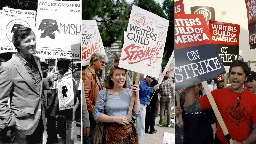
The common refrain is that there’s nothing Hollywood loves so much as its own history — but that’s a history inextricable from its labor movements.
As the industry comes to a momentous halt courtesy of dual strikes by its actors and screenwriters, it’s worth looking back at the effects of past protests, walkouts and other actions.
The Screen Actors Guild and the Screen Writers Guild, the forerunner to today’s Writers Guild of America, were each founded in 1933, though threads of collective action and solidarity run to the very beginnings of the motion picture industry. Picketers carry signs outside Disney studios on Monday, July 17, 2023, in Burbank, Calif. The actors strike comes more than two months after screenwriters began striking in their bid to get better pay and working conditions and have clear guidelines around the use of AI in film and television productions. (Jordan Strauss/Invision/AP)
You watch movies. You watch TV. And now you’re wondering how the pitched battle — with Hollywood’s actors and writers on one side, and studios and streaming services on the other — will affect you. Striking writers and actors take part in a rally outside Paramount studios in Los Angeles on Friday, July 14, 2023. This marks the first day actors formally joined the picket lines, more than two months after screenwriters began striking in their bid to get better pay and working conditions. (AP Photo/Chris Pizzello)
Three years after the pandemic brought Hollywood to a standstill, the film and TV industry has again ground to a halt. An advertisement for streaming service Paramount+ appears above striking writers and actors at rally outside Paramount studios in Los Angeles on Friday, July 14, 2023. This marks the first day actors formally joined the picket lines, more than two months after screenwriters began striking in their bid to get better pay and working conditions. (AP Photo/Chris Pizzello)
Hollywood productions and promotional tours around the world have been put on indefinite hold as actors join writers on the picket lines. SAG-AFTRA president Fran Drescher and SAG-AFTRA National Executive Director and Chief Negotiator Duncan Crabtree-Ireland, center, pose with SAG-AFTRA members during a press conference announcing a strike by The Screen Actors Guild-American Federation of Television and Radio Artists on Thursday, July, 13, 2023, in Los Angeles. This marks the first time since 1960 that actors and writers will picket film and television productions at the same time. (AP Photo/Chris Pizzello)
Hollywood actors are joining screenwriters in the first dual strike from the two unions in more than six decades, with huge consequences for the film and television industry.
At its founding, SAG boasted less than two dozen members. Ninety years later, 65,000 SAG-AFTRA members are on strike (the two actors unions merged in 2012).
For a few decades, strikes erupted at a regular cadence. The first actors strikes came in the 1950s, and a SWG strike in 1953 secured the first television residuals. But protests largely tapered off by the late 1980s.
Before 1950, strikes were about basic working conditions, said Kate Fortmueller, associate professor of film and media history at Georgia State University and an expert in Hollywood labor history.
“Post-1950, the concerns are more about residuals, replays, so like distribution. So it’s less about sort of how we’re working and more about how do we share in the profits that our work continues to generate?” she said. The 2023 strikes, Fortmueller said, marks a return to the more fundamental concerns about working conditions — and existential worries about the industry’s future.
Throughout it all the guilds have faced essentially the same opponent: the Alliance of Motion Picture and Television Producers. First a conglomerate of studio heads, it evolved to include studios and networks, and now boasts streamers and other major production companies, Fortmueller said.
“These streaming companies have origins in tech. And tech is a very different labor culture than Hollywood, in part because tech is not heavily unionized. And Hollywood has been for almost 100 years,” Fortmueller said, characterizing a major animating factor in AMPTP’s evolution.
In a rare but major exception, the studios were not a combatant in one of Hollywood’s most lurid strikes, a 227-day dispute between two so-called below-the-line unions that became defined by a single day. Whether you prefer “Bloody” or “Black” as the descriptor to that Friday in early October 1945, the resulting moniker for the melee in the Warner Bros. studio lot is appropriately weighty.
It may be tempting to prognosticate about the end of these concurrent strikes, but history is of little help here: Past strikes have spanned months and lasted minutes. Nonetheless, they’re instructive for how the issues that drove the conflicts and the resolutions set the stage for today’s disputes. Each success and failure has contributed to shaping the contemporary landscape.
Here’s a look at some of the most significant strikes in Hollywood labor history. 2007-2008 writers strike: 100 days
KEY ISSUE: Compensation, including residual payments, for shows and movies distributed digitally
MAIN RESULTS: Jurisdiction over projects created for the internet under certain guidelines; set compensation for ad-supported streaming programs; increased residuals for downloaded shows and movies
Since it was the most significant Hollywood strike in decades, it’s the one most etched in most people’s memories. All told, it had an estimated $2 billion impact on the California economy and is often credited with sending programming further into reality television’s clutches (even if such gems as NBC’s “My Dad Is Better Than Your Dad” didn’t have much staying power).
While an analyst at the time told the AP the strike was “an unqualified success,” some WGA members felt they were pressured into accepting weaker terms because the Directors Guild of America negotiated their own contract on similar issues. A specter of that discontent reared its head again 15 years later, when the DGA reached a “truly historic” tentative agreement with AMPTP a little over a month into the 2023 writers strike.
“They have all these other concerns, like with prestige and credit and authorship ... and things that are not as tangible,” Fortmueller said of the directors guild’s priorities through the ages. 1988 writers strike: 154 days
KEY ISSUE: Residuals for television shows sold to foreign markets
MAIN RESULTS: More creative control over scripts and the reacquisition of original screenplays; salary increases, though guild negotiators said they were less successful in winning larger payments for the foreign market reruns
This contract was ratified on the 154th day of the strike, making it the longest WGA strike by a margin of one day.
“It was a very difficult time. Over a period of time, some of the rancor and anger will be forgotten. I don’t think the spirit will be forgotten, though. They (the writers) will remember this for a long time,” WGA spokesperson Cheryl Rhoden said at the time.
Fortmueller also noted that this strike really marked the birth of reality TV as a way to fill time in vacant schedule blocks. 1981 writers strike: 96 days; 1980 actors strike: 77 days
KEY ISSUE: The fast-growing home video and pay TV markets
MAIN RESULTS: Share of producer revenues from those markets; increase in base pay
While these strikes happened nearly a year apart, the core issue was the same: Actors and writers wanted a portion of the revenue generated in quickly growing markets — there was money to be made on videocassettes.
In 1980, SAG, AFTRA and the American Federation of Musicians all went on strike. In the longest strike in their history, the actors ended up winning the industry’s first pay TV concessions. The musicians had no such luck, despite striking for 167 days.
The following year, striking writers won similar concessions, and WGA spokespeople characterized it as the most extensive and precedent-setting deal the guild had negotiated in two decades. 1973 writers strike: 111 days
KEY ISSUES: Pay and benefits
MAIN RESULTS: Salary hikes, guaranteed residual pay schedules for movies on cassettes and pay TV
While the 1973 writers strike technically lasted for 16 weeks, work was not necessarily halted the entire time. The strike didn’t extend to soap operas and variety shows until more than a month in — and those effects were more immediately tangible.
Around 10 weeks into the strike, the boycotts were pared back to just the major television and film studios that comprised the AMPTP. By that point, more than 150 independent producers — who controlled more than 50% of primetime television — had signed the new contract and were allowed to get back to work. 1960 writers and actors strike: 153 days (WGA), 43 days (SAG)
KEY ISSUES: Foreign and subsidiary rights on television scripts, rerun rights, proceeds from the sale of post-1948 films to television, a pension system for SAG
MAIN RESULTS: Actors and writers won salary bumps, residual payments for films released to TV and — most crucially — the establishment of pension, health and welfare funds; writers agree to waive claims on revenue from the sale of pre-1960 movies to TV
The writers quite literally struck first, and would strike longer, but it was SAG — with its starry membership — that would be first to secure pension, health and welfare funds. In a marked departure from today’s raucous and punny picket lines, the guilds did not picket or demonstrate, according to contemporaneous articles that called the nature of the strikes “firm but polite.”
“This is what studios were afraid of in the ’20s and ’30s, is nobody wants to see your stars on a picket line. It’s not the optics that Hollywood wants,” Fortmueller said of how the actors’ decision to strike changed the calculus. Writers also tend to be on the same page, with similar responsibilities; so if a guild as diverse in roles as SAG-AFTRA is today overwhelmingly chooses to strike, she noted, that telegraphs the severity of the situation.
SAG was helmed by Ronald Reagan, who represented his fellow actors at the bargaining table alongside arguably bigger celebrities of the time, like Oscar winner Charlton Heston and James Garner, then the star of TV ratings juggernaut “Maverick.” Just two decades later, Reagan — as U.S. president — would become known as one of the most damaging figures in the country’s labor history for his firing of thousands of air traffic controllers during their 1981 strike.
A 1960 AP story announcing an initial settlement for the actors underlined the magnitude of the strike as “unique in labor history because millionaires were as thick on labor’s side as they were on management’s.”
SAG-AFTRA’s chief negotiator, Duncan Crabtree-Ireland invoked the spirit — and gains — of the 1960s last week at the press conference announcing the strike.
“This is the first SAG-AFTRA strike in this contract in over 40 years,” he said. “This is not a strike-happy union. This is a union that views strikes as a last resort but we’re not afraid to do them when that is what it takes to make sure our members receive a fair contract.”
-
Laid-off Twitter Africa team 'ghosted' without severance pay or benefits, former employees say [Full text]
www.cnn.com Laid-off Twitter Africa team 'ghosted' without severance pay or benefits, former employees say | CNN BusinessFormer employees of Twitter Africa who were laid off as part of a global cost-cutting measure after Elon Musk’s acquisition have not received any severance pay more than seven months since leaving the company, several sources told CNN.
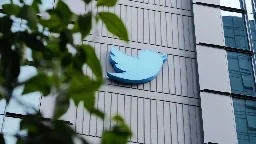
Former employees of Twitter Africa who were laid off as part of a global cost-cutting measure after Elon Musk’s acquisition have not received any severance pay more than seven months since leaving the company, several sources told CNN.
In late May, the former employees, who were based in the Ghanaian capital Accra, accepted Twitter’s (TWTR) offer to pay them three months worth of severance, the cost of repatriating foreign staff and legal expenses incurred during negotiations with the company, but they have not received the money or any further communication, the sources said.
“They literally ghosted us,” one former Twitter Africa employee told CNN.
“Although Twitter has eventually settled former staff in other locations, Africa staff have still been left in the lurch despite us eventually agreeing to specific negotiated terms.”
The former employees say they reluctantly agreed to the severance package without benefits, even though it was less than what colleagues elsewhere received.
“Twitter was non-responsive until we agreed to the three months because we were all so stressed and exhausted and tired of the uncertainty, reluctant to take on the extra burdens of a court case so we felt we had no choice but to settle,” another former employee told CNN.
The former employees spoke to CNN on condition of anonymity because they said they were asked to sign non-disclosure agreements as part of their exit terms.
According to Carla Olympio, an attorney who is representing the former employees, the last communication from Twitter or its lawyers was in May, shortly after settlement was agreed.
CNN reached out to Twitter for comment on the status of the severance package for the former employees in the Ghana office but received an automated response – a poop emoji. It’s unclear whether Twitter still has a media relations department.
In March, Musk tweeted that Twitter would respond to all press inquiries with the poop emoji. He completed a deal to buy the social media platform in October.
CNN also asked Ghana’s Ministry of Employment and Labor Relations for comment. A spokesperson said they are investigating the claims.
Whether Ghanaian authorities can compel Twitter to comply with the settlement is uncertain. The former employees and their attorney say the offer was never finalized.
The dozen or so team members were laid off just four days after the social network opened a physical office in Accra last November.
Some of them said they had moved to Ghana from other African nations, and depended on their jobs at Twitter to support their legal status in the country.
“Unfortunately, it appears that after having unethically implemented their terminations in violation of their own promises and Ghana’s laws, dragging the negotiation process out for over half a year, now that we have come to the point of almost settlement, there has been complete silence from them for several weeks,” Olympio said.
Twitter and Musk face multiple lawsuits where plaintiffs are claiming the company has failed to pay former staffers what they are owed.
Last week, a former US employee filed a proposed class action lawsuit claiming the company didn’t pay the full amount of severance benefits it promised last November prior to mass layoffs.
The plaintiff said Twitter promised senior employees severance of six months of base pay plus one week for every year of service, in addition to other benefits. Instead, the plaintiff said they received a total of three months of pay, according to the lawsuit. In response to a request for comment on the lawsuit, Twitter sent CNN an automated poop emoji.
In April, Musk told the BBC more than 6,000 people had been laid off since he completed his acquisition of the company in late October.
“We’re exploring our options with respect to causes of action against Twitter in various jurisdictions including Ghana,” Olympio told CNN.
Twitter did not open negotiations with the African team until after CNN reported in November that they had been offered separation terms that differed from those offered to departing staff in Europe and North America.
-
Senators introduce bipartisan ban on stock ownership for executive and legislative branch office holders and their families [Full text]
www.cnn.com Senators introduce bipartisan ban on stock ownership for executive and legislative branch office holders and their families | CNN PoliticsNew York Democratic Sen. Kirsten Gillibrand and Missouri Republican Sen. Josh Hawley are introducing bipartisan legislation that would prevent members of the executive and legislative branches — as well as their spouses and children — from trading individual company stocks.

New York Democratic Sen. Kirsten Gillibrand and Missouri Republican Sen. Josh Hawley are introducing bipartisan legislation that would prevent members of the executive and legislative branches — as well as their spouses and children — from trading individual company stocks.
The legislation will also ban blind trusts, require increased filing transparency, and significantly increases penalties for violations, including fines of at least 10% of the value of the prohibited investments for members of Congress.
“Sunlight is the best disinfectant. It is critical that the American people know that their elected leaders are putting the public first – not looking for ways to line their own pockets,” Gillibrand said in a statement.
The Senate bill builds upon a proposed bill in the House that would ban members from trading stocks, but did allow members of Congress, their spouses and their dependent children to put certain investment assets into a qualified blind trust while the member is in office. The Senate’s version would ban that provision.
“Politicians and civil servants shouldn’t spend their time day-trading and trying to make a profit at the expense of the American public, but that’s exactly what so many are doing,” Hawley said. “My bill with Senator Gillibrand is common sense: ban elected and executive branch officials from trading or holding stocks, and put the American public first.”
- www.theguardian.com The 1 cent paycheque: here’s the awful truth about being an actor in the ‘golden’ age of streaming
While streaming services rake in hundreds of millions of dollars, many TV stars can’t even afford heating – or are somehow paid in negative figures. No wonder they’re on strike

-
Hollywood Shuts Down After 160,000 Actors Walk Off the Set
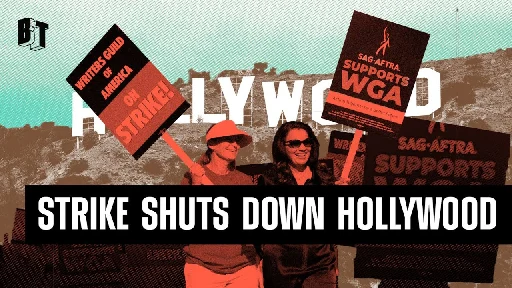
YouTube Video
Click to view this content.







